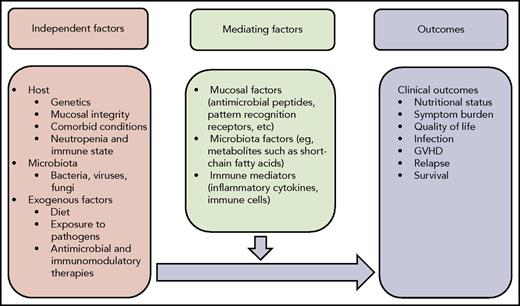In this issue of Blood, Haak et al describe an association between the abundance of butyrate-producing intestinal bacteria early after allogeneic hematopoietic cell transplantation (HCT) and the subsequent occurrence of lower respiratory tract viral infections during the first 6 months after transplant.1
Model of the interaction of host, microbiota, and exogenous factors to generate mediating factors that affect the occurrence or protection from HCT complications. GVHD, graft-versus-host disease.
Model of the interaction of host, microbiota, and exogenous factors to generate mediating factors that affect the occurrence or protection from HCT complications. GVHD, graft-versus-host disease.
Is this a chance association or is there a causal link? There are numerous endogenous and exogenous risk factors for infections after HCT and often there are multiple contributing factors that make causal relationships difficult to elucidate. The authors appropriately performed multivariate analyses of multiple pertinent clinical risk factors to exclude confounding clinical factors and were successful in concluding that gut microbiota at time of engraftment was an independent risk factor.
There are several limitations of the analyses. One could argue about the validity of the case definition of lower tract infection. The case definition has been a point of argument in other studies of viral respiratory infection: pulmonary infiltrates are not accurate in proving a particular microbiological etiology and even detection of an organism from a lower tract specimen, such as bronchoalveolar lavage, does not exclude contamination from the upper tract. One could inquire about studying gut microbiota when an assessment of the upper respiratory microbiota might have been more germane to study because of its proximity to the portal of entry and the site of infection; other studies suggest loss of diversity of upper respiratory microbiota diversity is associated with lower tract infection.2 One could ask why the microbiota pattern at engraftment would have long-lasting effects affecting the risk for events months later. Moreover, does restoration of butyrate-producing populations at a later time after engraftment occur in some patients and, if so, does restoration abrogate the risk? One could ask if the associations found at this single center are unique because specific institutional transplant or antimicrobial practices differ from other centers, or is this finding generalizable for other transplant centers? Not explored in this study and relatively unexplored in other studies are the roles of the mycobiome and virome on immunity; they are likely to have important roles as well. All are issues that future studies should probe.
Notwithstanding those limitations, there is a sound scientific basis to believe that the link may be real. As the authors note, animal models have shown that gut microbiota can protect against both bacterial and viral respiratory infections and can be manipulated. The authors focused on butyrate-producing bacteria, reasoning from findings in an earlier study that this bacterial metabolite can reduce lung inflammation and injury during pneumonia by reduction of tumor necrosis factor and maintenance of interleukin-10.3 The authors argue that engraftment is a crucial time for immune reconstitution and thus the microbiota at that time could have pivotal and lasting effects in shaping protective immunity. Thus, there is a scientific rationale to support this finding to be something more than merely an association only. Associations of gut dysbiosis with multiple other clinical complications after HCT have been described, including serious bacterial infections, graft-versus-host disease, relapse, and survival.4 Finally, a recent presentation at the 2018 Bone and Marrow Transplantation Tandem Meetings indicates that the microbiota changes in patients treated at 3 centers were similar, providing some reassurance that the observations are likely not merely center specific.5
The evidence mounts for important interactions between the host and its microbiome that lead to health or disease. The mechanisms of how the gut microbiota shapes immune responses are incrementally being unraveled. There are multiple factors that interact in complicated ways. A crude model of how some of these factors interact is displayed in the figure. There are a multitude of antecedent host factors and exogenous factors such as diet, antibiotic and immunomodulatory therapies, and pathogen exposure that interact to create a person’s microbiome. These then generate a variety of mediating factors from host and microbiota that inform immune reconstitution in ways that then result in HCT complications or protection from adverse outcomes. The mediating effects of bacterial metabolic products, especially small chain fatty acids, are being detailed, as is highlighted in this paper. This paper adds to the list of HCT outcomes that implicate the gut microbiota.
So far much of the evidence implicating microbiome is circumstantial. Proof of causality will await confirmation in several ways. An animal model that manipulates the microbiota and replicates the disease is 1 important means to demonstrate causation. Certainly, prevention of disease by altering the microbial constituents by diet, pre- or probiotics, or changes in antimicrobial practices is another approach. Taking the microbiota from an individual without disease and administering to a patient with disease and inducing remission (as is done by fecal transplants) is yet a third approach. Such approaches are under way and the implications of what this all means and how to manipulate the situation favorably will be a story to watch in the upcoming years.
Conflict-of-interest disclosure: The author declares no competing financial interests.


